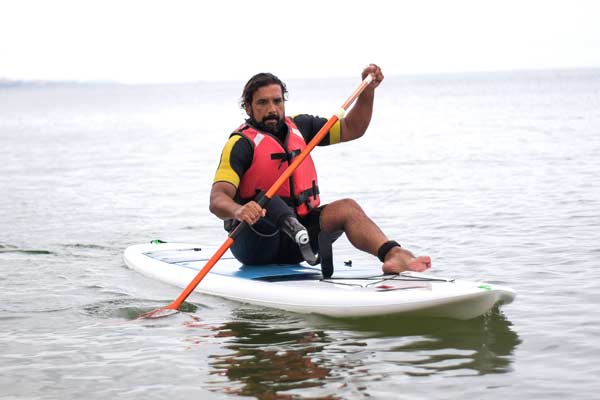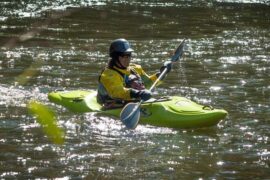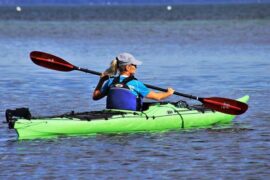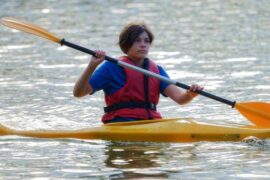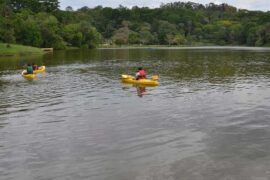Kayaking is enjoyable, so more people will include it in their weekend plans, especially if they own a kayak.
Therefore, the most commonly asked question is when does the kayaking season start?
The short answer is from late spring to autumn but really there is no specific time can be defined as the best time to start.
However, some areas are more conducive to kayaking all year round when compared to others. Some argue there need not be a specific kayaking season with the correct information and gear.
Different people have different answers to this question, so it is best to use the set indicators to guide you on when kayaking season should start. Some of the things to look out for include;
-
Climate
Both air and water temperatures are necessary when you want to start your kayaking season. You should pay closer attention to the water temperatures because even when it is hot, the water takes a while to become warm.
The general guide of a season when you can kayak is when the waters are not below 60 degrees Celsius, and the temperatures do not go below 70 degrees Celsius.
This is because temperature below either of the stated figures for air and water will require more effort, gear, and clothing for you to kayak.
Be cautious about kayaking when the combination of the air and water temperatures is below 120 degrees Celsius. This is a skill that experienced kayakers have, and beginners learn so that you can judge when the season favors you to start kayaking.
The tidal and wind strength should guide you on when to start a kayaking season. It is best to steer clear of kayaking when there is a higher gravitational pull between the moon and the sun.
This condition makes it harder to paddle through the high waves and increases the chances of the kayak overturning.
-
Location
Different locations will have a difference in the times when it is suitable to kayak. This is because some areas are warmer throughout the year, making the waters conducive for year-round kayaking.
Factors such as rainfall duration and intensity can affect how much water is available in a water body and if it is enough for your kayak to float. This means that different States will have varied kayaking seasons.
For instance, it is possible to kayak all through the year if you live in the Southwestern states of the US, such as southern California, Arizona, and New Mexico.
This is because these areas rarely have cold temperatures; thus, the warm waters suffice for most of the year. These areas also have less harsh winters, and you can kayak then.
-
Experience
Certain circumstances can qualify some people to kayak in some seasons and completely disqualify others. One of these factors is the experience level of the kayaker.
An experienced kayaker is more equipped to handle rougher climatic conditions to the extent of kayaking in the winter.
As you get better at kayaking, you will learn skills that help you stay afloat, react during rapid water changes, and get back on top of the kayak overturns. With these skills, your season can be all year round with other precautions.
-
Goal
People kayak for different reasons, which means that what is not suitable at the start of one season is perfect for another.
If you kayak for fishing reasons, then you want to pick a time when the waters are clear so that you can spot the fish. The best months for kayak fishing are May and April, which are spring months.
If you are kayaking for leisure and are combining this with photography, swimming, and camping, choose the autumn and spring months.
This is because you can easily spot more wildlife in these months, and the trees are shedding, creating a dramatic look.
-
Holidays
Sometimes, people will dictate when the kayak season will start based on the holidays. Holidays that fall between March and October jumpstart the kayak season because it is a family activity that people can enjoy during Thanksgiving and Christmas.
Even if you have a private kayak, the waters will most likely be crowded by the massive turnout of people on holiday.
-
Waters
You can kayak in most waters if you have the right equipment and pick a suitable time. Some seasons completely close off the idea of kayaking in specific waters and, most significantly, shallow waters during cold months.
This is because the water tends to freeze quickly and unevenly, meaning you may start at a part that is not frozen and end up stuck further down the river.
-
Off Seasons
Contrary to the weather conditions, it is possible to kayak all year round, even during winter, if you take the necessary safety measures.
The most significant bone of contention is kayaking during winter because it poses so many eventualities of things that can go wrong, thus why many people are discouraged.
The most dangerous outcome is if your kayak overturns and you fall into the icy waters. This poses significant physical and mental health because of the sudden drop in body temperatures that cause hypothermia. So how can you successfully make winter a kayaking season? The measures to take include;
- Clothing
Dress warmly and avoid wearing a wet suit if the waters are 50 degrees Celsius and above. Ensure you cover areas where you lose heat the most, such as your head and toes. Wearing padding gloves will stop the cold water from freezing your hands, affecting your paddling.
The recommended clothing items include a dry suit, fleece cap, rash guard, full face covering, and waterproof shoes. A good quality life vest is necessary, and carry an extra one for extra precaution.
- Equipment
You will need to get a kayak with sufficient storage to keep all the equipment you may need if there is an emergency.
You will need an air horn, fire starter, first aid kit, and emergency radio. Use a spray skirt to insulate the kayak’s top and prevent water from entering.
- Other Measures
Learning how to get back on the kayak if you fall in the water can be the difference between life and death.
Since it is a complex skill to learn, we suggest you master it before embarking on this winter venture. Inform your friends of the route you’ll be taking an estimated return time as an extra safety measure.
There are no set seasons as to when kayaking should start. In most water bodies, warm seasons such as spring, summer, and autumn are preferred and safest to kayak. The factors above affect kayaking differently and should be considered before making any decisions.
